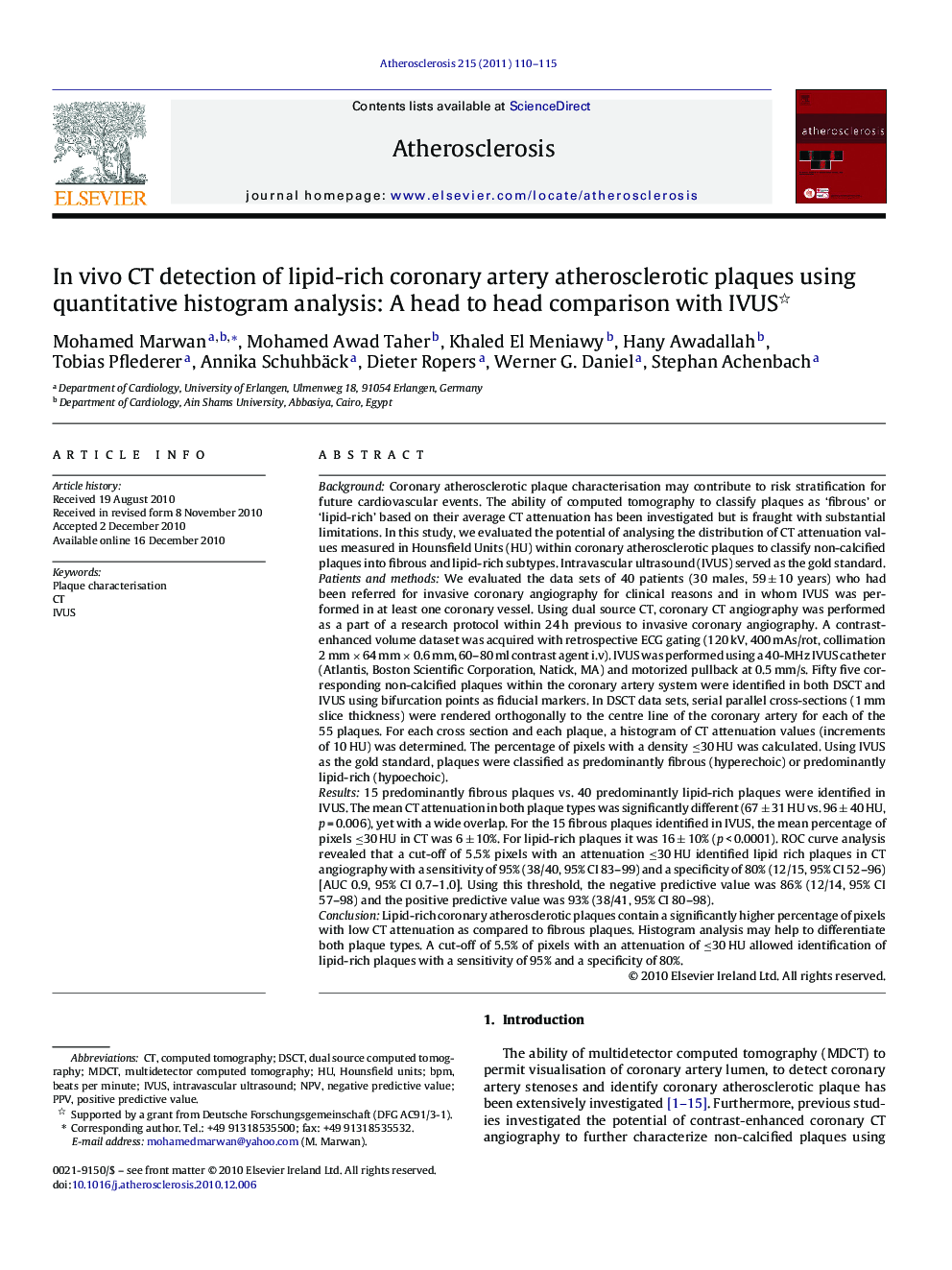| کد مقاله | کد نشریه | سال انتشار | مقاله انگلیسی | نسخه تمام متن |
|---|---|---|---|---|
| 2892894 | 1172397 | 2011 | 6 صفحه PDF | دانلود رایگان |

BackgroundCoronary atherosclerotic plaque characterisation may contribute to risk stratification for future cardiovascular events. The ability of computed tomography to classify plaques as ‘fibrous’ or ‘lipid-rich’ based on their average CT attenuation has been investigated but is fraught with substantial limitations. In this study, we evaluated the potential of analysing the distribution of CT attenuation values measured in Hounsfield Units (HU) within coronary atherosclerotic plaques to classify non-calcified plaques into fibrous and lipid-rich subtypes. Intravascular ultrasound (IVUS) served as the gold standard.Patients and methodsWe evaluated the data sets of 40 patients (30 males, 59 ± 10 years) who had been referred for invasive coronary angiography for clinical reasons and in whom IVUS was performed in at least one coronary vessel. Using dual source CT, coronary CT angiography was performed as a part of a research protocol within 24 h previous to invasive coronary angiography. A contrast-enhanced volume dataset was acquired with retrospective ECG gating (120 kV, 400 mAs/rot, collimation 2 mm × 64 mm × 0.6 mm, 60–80 ml contrast agent i.v). IVUS was performed using a 40-MHz IVUS catheter (Atlantis, Boston Scientific Corporation, Natick, MA) and motorized pullback at 0.5 mm/s. Fifty five corresponding non-calcified plaques within the coronary artery system were identified in both DSCT and IVUS using bifurcation points as fiducial markers. In DSCT data sets, serial parallel cross-sections (1 mm slice thickness) were rendered orthogonally to the centre line of the coronary artery for each of the 55 plaques. For each cross section and each plaque, a histogram of CT attenuation values (increments of 10 HU) was determined. The percentage of pixels with a density ≤30 HU was calculated. Using IVUS as the gold standard, plaques were classified as predominantly fibrous (hyperechoic) or predominantly lipid-rich (hypoechoic).Results15 predominantly fibrous plaques vs. 40 predominantly lipid-rich plaques were identified in IVUS. The mean CT attenuation in both plaque types was significantly different (67 ± 31 HU vs. 96 ± 40 HU, p = 0.006), yet with a wide overlap. For the 15 fibrous plaques identified in IVUS, the mean percentage of pixels ≤30 HU in CT was 6 ± 10%. For lipid-rich plaques it was 16 ± 10% (p < 0.0001). ROC curve analysis revealed that a cut-off of 5.5% pixels with an attenuation ≤30 HU identified lipid rich plaques in CT angiography with a sensitivity of 95% (38/40, 95% CI 83–99) and a specificity of 80% (12/15, 95% CI 52–96) [AUC 0.9, 95% CI 0.7–1.0]. Using this threshold, the negative predictive value was 86% (12/14, 95% CI 57–98) and the positive predictive value was 93% (38/41, 95% CI 80–98).ConclusionLipid-rich coronary atherosclerotic plaques contain a significantly higher percentage of pixels with low CT attenuation as compared to fibrous plaques. Histogram analysis may help to differentiate both plaque types. A cut-off of 5.5% of pixels with an attenuation of ≤30 HU allowed identification of lipid-rich plaques with a sensitivity of 95% and a specificity of 80%.
Journal: Atherosclerosis - Volume 215, Issue 1, March 2011, Pages 110–115